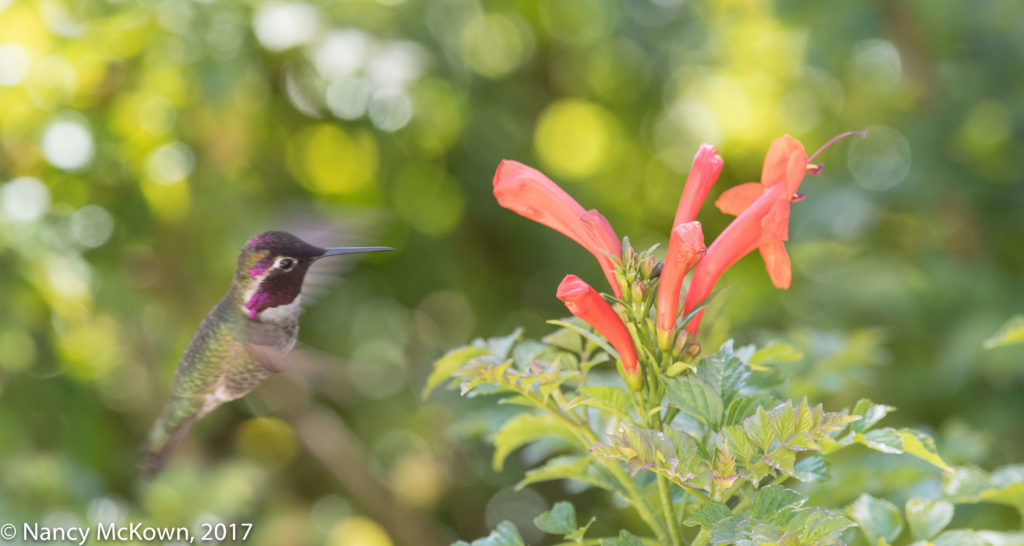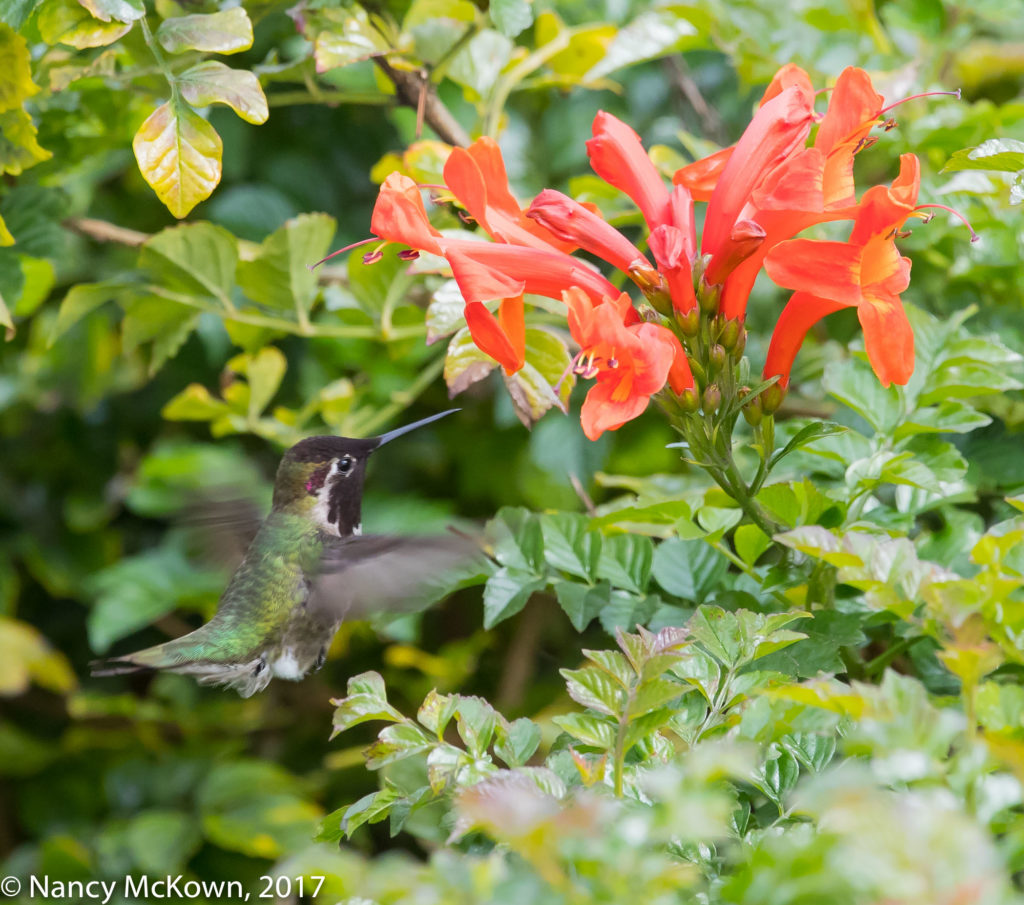Photographing An Anna’s Hummingbird
Bird photography opportunities rarely come at times when the light is optimal.
These images of an Anna’s Hummingbird were captured in sunny San Diego at mid-day. The camera and 300mm lens with 1.4 extender were pointing downward toward a row of flowering bushes. I took a few shots using only the drop-in gelatin filter that came with the lens. (See image directly below.) I then removed the gelatin filter and dropped in Canon Circular Polarizing Filter (PL-C52). It took a while for my hands to get used to positioning the filter with the external control rotation wheel. Eventually I got the hang of it.
What a difference! (See second image below.)

Mid day Sun Overhead. No Polarizer on Lens.
Colors are Muted. Image Looks Washed Out.
Lots of Flare and Glare on the leaves
ISO1000; f/6.3; 1/500 Second
(NOTE: This drop-in circular polarizing filter will fit in both of my telephoto lenses – the EF300 f/2.8 L IS II and the EF500mm f/4L IS II.)
Long Lens Circular Polarizers
A polarizer manages reflections and cuts glare in much the same way as polarizing sunglasses do.
- A polarizer will reduce the amount of light reaching the sensor and impact your exposure settings (from 1-3 stops).
- Circular polarizers have dials which must be rotated to optimally cut glare. As you rotate the polarizer, your goal is to dial-in the best color saturation and contrast and dial out reflection and glare. The end result should be more balanced light on the scene. (NOTE: You simply can’t do this much glare reduction in post processing).
- If a bird flies to a shady spot– a no glare zone– the polarizer does not negatively impact the image, except for light loss.
- Wearing polarized sunglasses while using a circular polarizer on your lens will prevent you from seeing all the leafy glare and rotating the filter optimally. In addition, polarized sunglasses on top of polarized drop-in filter make for dark and difficult viewing.
- Polarizers are most effective when the lens is pointed at a right angle to the sun. Depending on the location of the bird and the angle of your lens, the polarizing impact may not be uniform across the whole image.
- Because you must dial in the best position for optimal glare control, composing may take longer. (NOTE: Repositioning the polarizer was a constant battle as this hummer flitted up and down forcing me to change the len’s trajectory and re-rotate the polarizer’s dial.)
- Linear polarizers are cheaper, but won’t work with auto exposure and auto focusing functions– making them pretty useless for bird photography.

300 mm lens with 1.4 extender
and Circular Polarizer Inserted.
Did Not Remove All Reflections
But the Image Looks Much Better.
ISO1600; f/7.1; 1/1000 Second
Lens Flare and Lens Glare
Lens flare is no more than stray light (usually unintentional and undesirable) sneaking in and bouncing around the inside of a camera lens and leaving on your images an assortment of light specters, streaks, fogging and ghost images shaped like the diaphragm of the lens. Lens Flare is almost always a consequence of backlighting coming into the lens. To control or otherwise reduce flare, you either move the lens or attempt to shield it, using a hood on the lens barrel, your hand, your hat, or a polarizing filter.
Glare is reflected and scattered light on the surface of water, leaves, flowers, glass, bald heads, etc that does not necessarily originate from the lens.
Filters On A Long Lens
In all my long years as a photographer, I never purchased a polarizer or any kind of filter for my lenses, until now. I assumed that these tools were better suited for landscape photographers even though I often found unbalanced light and shimmery glare on my bird images. I should have known better.
Soft, diffused natural light is elusive….even when you show up at the right time and follow all the rules. Too much mid-day unshielded sunlight... contrasty and harsh, is impossible to avoid and hard to control without proper equipment to make shade or reduce shadows.
You can’t purchase filters large enough to put on the end of Canon’s big telephoto lenses. Most of Canon’s longer telephoto lenses come equipped (close to the base of the lens) with a drop-in gel filter holder (with a clear glass filter installed). Quality drop-in circular polarizers are expensive, and only useful on longer lenses.
Bottom line, the best quality of light for bird photography is still sun rise or sun set. However, opportunities abound for bird photography at mid day. A polarizing filter is a good light weight solution to tame the sun.









can’t wait to see the hummers back in Michigan! this california hummer is a beauty